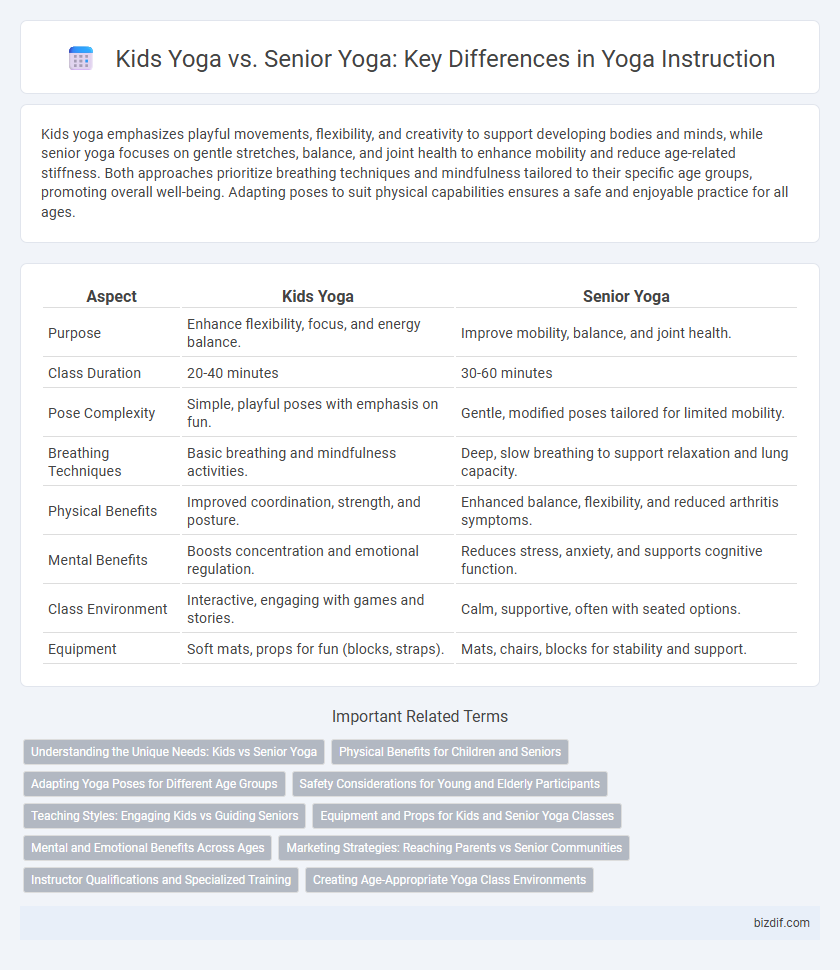Kids yoga emphasizes playful movements, flexibility, and creativity to support developing bodies and minds, while senior yoga focuses on gentle stretches, balance, and joint health to enhance mobility and reduce age-related stiffness. Both approaches prioritize breathing techniques and mindfulness tailored to their specific age groups, promoting overall well-being. Adapting poses to suit physical capabilities ensures a safe and enjoyable practice for all ages.
Table of Comparison
| Aspect | Kids Yoga | Senior Yoga |
|---|---|---|
| Purpose | Enhance flexibility, focus, and energy balance. | Improve mobility, balance, and joint health. |
| Class Duration | 20-40 minutes | 30-60 minutes |
| Pose Complexity | Simple, playful poses with emphasis on fun. | Gentle, modified poses tailored for limited mobility. |
| Breathing Techniques | Basic breathing and mindfulness activities. | Deep, slow breathing to support relaxation and lung capacity. |
| Physical Benefits | Improved coordination, strength, and posture. | Enhanced balance, flexibility, and reduced arthritis symptoms. |
| Mental Benefits | Boosts concentration and emotional regulation. | Reduces stress, anxiety, and supports cognitive function. |
| Class Environment | Interactive, engaging with games and stories. | Calm, supportive, often with seated options. |
| Equipment | Soft mats, props for fun (blocks, straps). | Mats, chairs, blocks for stability and support. |
Understanding the Unique Needs: Kids vs Senior Yoga
Kids yoga emphasizes playful movements and imaginative poses to enhance motor skills, concentration, and emotional regulation, catering to their developing bodies and short attention spans. Senior yoga focuses on gentle, low-impact stretches and balance exercises designed to improve joint flexibility, strength, and reduce the risk of falls, addressing age-related physical limitations. Customizing yoga practices based on age-specific musculoskeletal and cognitive differences maximizes safety and effectiveness for both children and seniors.
Physical Benefits for Children and Seniors
Kids yoga enhances flexibility, coordination, and balance, promoting healthy bone growth and improving concentration. Senior yoga supports joint mobility, increases muscle strength, and reduces fall risk by enhancing stability and posture. Both age groups benefit from improved respiratory function and stress relief, tailored to their developmental and physiological needs.
Adapting Yoga Poses for Different Age Groups
Adapting yoga poses for kids involves incorporating playful movements and shorter sessions to maintain their attention and encourage motor skill development. In contrast, senior yoga emphasizes gentle stretches, balance exercises, and modifications that accommodate joint limitations and improve flexibility. Tailoring yoga practices to specific age groups enhances safety, engagement, and overall physical benefits.
Safety Considerations for Young and Elderly Participants
Kids yoga emphasizes gentle movements and playful poses to prevent injury and maintain engagement, while senior yoga prioritizes balance, joint health, and modified stretches to accommodate limited mobility and chronic conditions. Instructors must ensure proper supervision and age-appropriate techniques, using props and support to enhance safety for both young and elderly participants. Monitoring fatigue levels and encouraging gradual progression reduces the risk of strain for all ages in yoga practice.
Teaching Styles: Engaging Kids vs Guiding Seniors
Teaching kids yoga involves using playful, dynamic methods such as storytelling, games, and interactive poses to capture children's shorter attention spans and foster creativity. Senior yoga instruction emphasizes gentle, mindful guidance with a focus on balance, flexibility, and breath awareness to accommodate physical limitations and promote joint health. Instructors tailor their approaches by incorporating age-appropriate techniques that enhance engagement and safety for each demographic.
Equipment and Props for Kids and Senior Yoga Classes
Kids yoga classes often incorporate colorful mats, soft blocks, and playful props like stuffed animals to engage young participants and support balance and coordination. Senior yoga sessions prioritize ergonomic equipment such as sturdy chairs, non-slip mats, and bolsters to enhance stability and accommodate limited mobility. Both age groups benefit from age-appropriate props that promote safety, comfort, and effective posture alignment during practice.
Mental and Emotional Benefits Across Ages
Kids yoga enhances focus, emotional regulation, and stress relief by promoting mindfulness and self-expression during key developmental stages. Senior yoga improves cognitive function, reduces anxiety, and fosters emotional resilience through gentle movements and breathing exercises tailored to aging bodies. Both age groups benefit mentally and emotionally by cultivating calmness, increased self-awareness, and a positive outlook through age-appropriate yoga practices.
Marketing Strategies: Reaching Parents vs Senior Communities
Marketing strategies for kids yoga prioritize engaging parents through digital platforms, social media ads, and partnerships with schools and pediatric centers to highlight developmental benefits and fun, interactive sessions. Senior yoga marketing focuses on building trust within senior communities via local health clinics, retirement homes, and senior centers, emphasizing gentle exercises, wellness, and improved mobility for aging populations. Tailored messaging and targeted outreach are essential to effectively communicate value and foster enrollment in each distinct demographic.
Instructor Qualifications and Specialized Training
Instructor qualifications for kids yoga emphasize certifications in child development, pediatric anatomy, and playful engagement techniques, ensuring safe and age-appropriate sessions. Senior yoga instructors require specialized training in geriatric health, mobility challenges, and modifications for chronic conditions to support safe practice and enhance flexibility. Both disciplines demand expertise in tailored communication and adaptive teaching methods to meet the distinct needs of children and older adults effectively.
Creating Age-Appropriate Yoga Class Environments
Creating age-appropriate yoga class environments requires tailored approaches that address the unique needs of kids and seniors. Kids yoga classes emphasize playful movements, imaginative storytelling, and shorter session lengths to maintain engagement and develop motor skills. Senior yoga focuses on gentle stretches, balance exercises, and modifications for mobility limitations to enhance flexibility, strength, and overall well-being safely.
Kids yoga vs senior yoga Infographic

 bizdif.com
bizdif.com